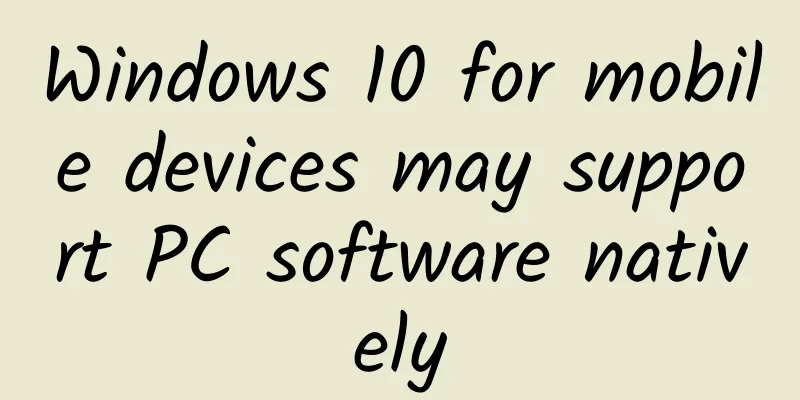Windows 10 for mobile devices may support PC software natively

|
The HP Elite x3 , released earlier this year, reflects Microsoft's philosophy of integrating mobile phones with PCs. At present, it seems that the most important function of this phone, running PC software on the phone, will become the core function of Windows 10 mobile phones in the future. Windows observer WalkingCat discovered that through the "CHPE" design in the code, Windows 10 Mobile will be able to simulate and run x86 software on ARM processors. Mary Jo Foley, a reporter who follows Windows, also reported similar news. She said that "CHPE" refers to Microsoft's plan to enable Windows 10 Mobile to support emulation of x86 software in the Redstone 3 upgrade in the fall of 2017. The "C" stands for "Cobalt", which is the code for Microsoft's development of the x86 emulation project, "HP" stands for Hewlett-Packard, and the meaning of "E" is still unclear, but it may refer to "emulation". So, what does this mean? That's because native support for x86 software will greatly improve the usability of Continuum, one of Windows 10 Mobile's flagship features. Continuum makes your Windows phone feel like a PC by connecting an external display and keyboard. But currently, the only software that supports Continuum mode is "Universal Windows Platform" apps. These apps are few and far between, and don't include many of the key software that business users and PC enthusiasts need. In fact, the way HP Elite x3 runs x86 applications is also through a virtual cloud computing environment rather than running directly on the device. It sounds challenging to emulate full PC software on a mobile device, especially considering how resource-intensive a lot of that software is. Solving performance and battery life issues could be difficult. However, combining x86 software with the power efficiency of ARM would be a remarkable achievement in computing, and it would be great if Microsoft could pull it off. In October, Microsoft Windows chief Terry Myerson said: "There are two things about Windows Mobile that are very unique from a technical perspective. One is mobile data connectivity, and the other is the ARM processor. So we will continue to invest in ARM processors and mobile data connectivity. Although I didn't say what type of device, I think we will see Windows devices using ARM chips. We will also see devices that support mobile data connectivity." As a winner of Toutiao's Qingyun Plan and Baijiahao's Bai+ Plan, the 2019 Baidu Digital Author of the Year, the Baijiahao's Most Popular Author in the Technology Field, the 2019 Sogou Technology and Culture Author, and the 2021 Baijiahao Quarterly Influential Creator, he has won many awards, including the 2013 Sohu Best Industry Media Person, the 2015 China New Media Entrepreneurship Competition Beijing Third Place, the 2015 Guangmang Experience Award, the 2015 China New Media Entrepreneurship Competition Finals Third Place, and the 2018 Baidu Dynamic Annual Powerful Celebrity. |
<<: World Economic Forum: Europe in the Age of AI
>>: Huawei Q1 router review: specially designed to solve all kinds of WiFi signal problems
Recommend
QQ's new emoticon "Da Cai Wang" dominates the screen: no matter how big the phone screen is, it will never be blurred
Recently, Tencent Mobile QQ has launched version ...
Interview with Ironsource CEO Tomer Bar-Zeev: The internationalization of Internet products
[[126198]] With the development of the Internet a...
Case Study: Analysis of Jiliwawa’s Distribution System
Jiliwulala is an online children's enlightenm...
Nokia 5-inch Android phone review
Nokia launched three Android phones last month, bu...
Why are you not optimistic about the iPhone returning to 4 inches?
"The next generation iPhone will launch a 4-...
Is it a good thing to not gain weight? Let us help you understand the truth about obesity
Obesity may affect your good looks Or cause unexp...
Another one discovered! Is a world-class tiankeng cluster hidden in China?
After the scientific expedition team organized by...
The seventh episode of the Aite Tribe Clinic: What function was used to write the King of Pesticide Welfare Bureau?
【51CTO.com original article】 Activity description...
my country's new coronavirus special medicine may produce another "dark horse" that can prevent mutant strains!
0.6 grams of antibody per injection, one injectio...
I have heard of "husband and wife look alike", but what the hell is "human-dog look alike"? !
According to a study by Weird Psychology author W...
The details of the sun's surface are being revealed bit by bit: Observing the sun in the finest detail
[Mobile software: Bo Ke Yuan] Do you remember the...
Can a small screen also be used to create a "blockbuster"? Let your photos achieve the "depth of field effect" on your phone
1. Summary On iOS, when users set system wallpape...
Android ListView Optimization Best Practices
This blog teaches you how to use convertView and ...
Dream Sky Cabin, always ready!
According to the China Manned Space Engineering O...
If you jailbreak iOS 8, these premium plugins are worth a try
Although there are fewer and fewer reasons to jai...









